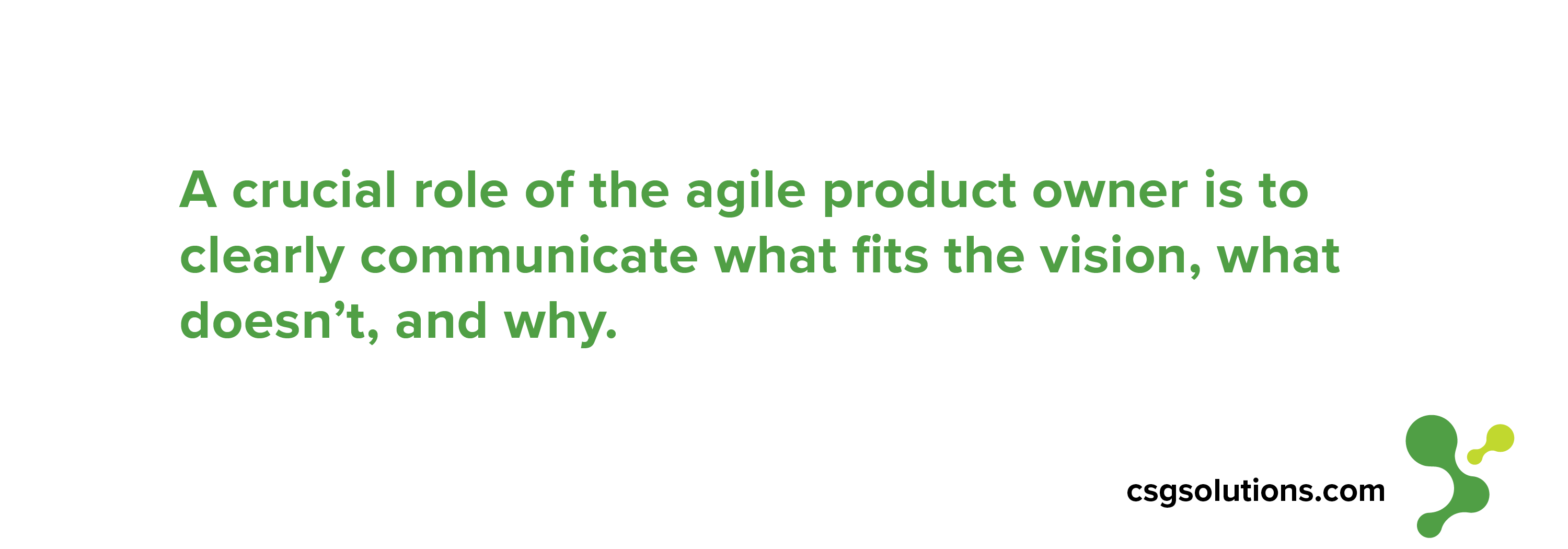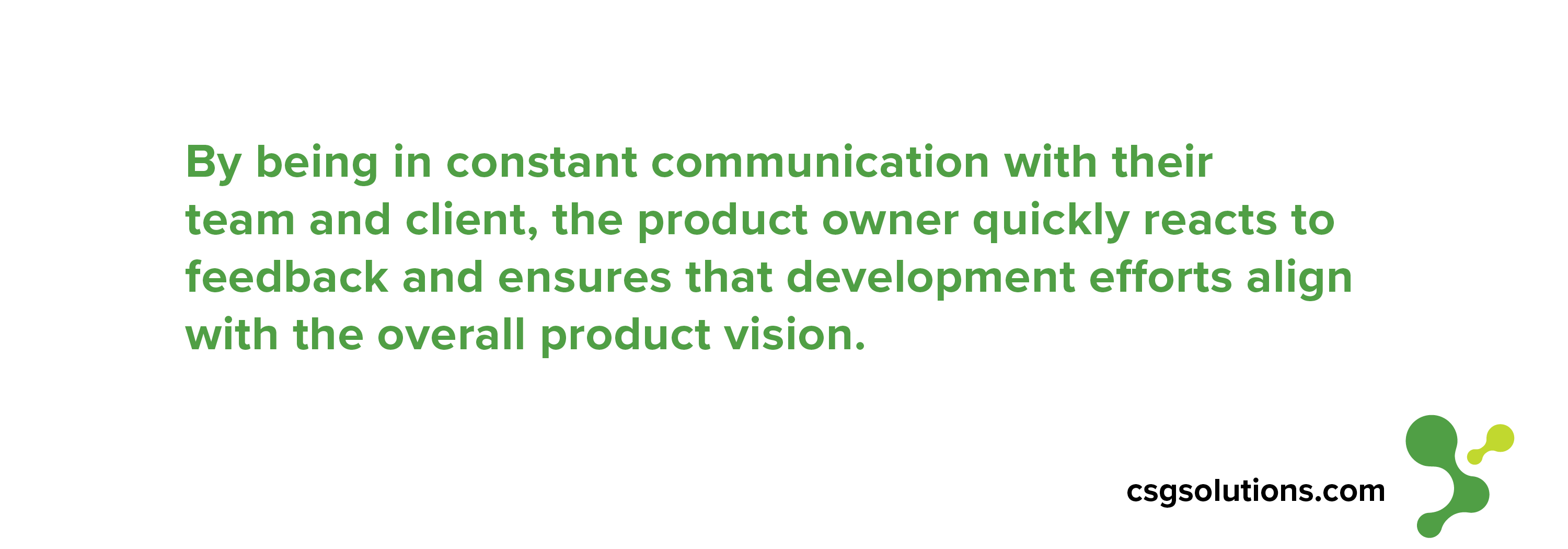6 Important Characteristics of a Successful Agile Product Owner
Product owners in the agile development process are responsible for everything from understanding and communicating the needs of their organization to casting the initial vision for the solution to ensuring the fulfillment of user stories by the development team. Agile product owners wear many hats and as a result have to be excellent communicators, team players, coordinators, decision-makers… the list goes on.
The agile product owner is involved in nearly every decision from discovery to delivery. They have to be a business strategist, product designer, market analyst, client liaison, and project manager all in one.
They are caught in the balancing act of keeping the market viability of the product at the forefront while still playing a role in coordinating the technical requirements and prioritizing those requirements for the team. They represent the needs of both the client and the development team- two different perspectives that don’t often speak the same language. The product owner is the master coordinator, key communicator, and driver of progress amidst all of these voices and needs.
So what characteristics make a successful product owner? Whether you’re looking to find the right person for your product owner role or if you’re a product owner that aspires to grow in your role, read on:
1- Visionary
As a visionary, the agile product owner provides high-level perspective for the development team. While involved in minute development details (for example, the color of certain text or a button in an application), they also keep the overarching goal in mind. They ensure that at every decision point, no matter how large or small, the product fulfills the overall vision, user needs, and stakeholder priorities.
Because they have this overarching perspective, the product owner is the best person to organize the product backlog and prioritize the order of feature development. They hold the vision for the product tightly and know most intricately how it will fulfill the client’s expectations. As a result they can properly discern and prioritize which features will provide the most value toward that vision.
Importantly, a product owner with vision and perspective won’t hone in on just one capability of the software. They manage the timeline and budget effectively so that too much time or detail isn’t put into a low-value feature. After the product is released, they use analytics to prioritize the continuous development of features that have a high level of user engagement. The successful agile product owner must have the big picture in mind, or they won’t successfully be able to direct the team’s focus.
2- Communicator
An agile product owner needs to be able to chart the course and communicate vision to key stakeholders and the development team. A crucial role of the agile product owner is to clearly communicate what fits the vision, what doesn’t, and why. Likewise, it is important that the product owner is a leader, empathetic, an excellent listener, and can translate ideas and concepts clearly to the team – they should be able to easily coordinate with people with diverse market knowledge, different communication styles and varying levels of technical expertise. They should reflect and intentionally ask for feedback from both the development team and the client regularly, being unafraid of transparency and conflict.

There are times in communicating the vision that the product owner must be okay with saying no. This may be a “no” to the development team who wants to move onto the next feature too soon or to the client who has an idea for a feature that really won’t add value or improve ROI.
The successful product owner will develop supportive relationships with both the development team and the client by exercising empathy, listening, and clear communication; this positive foundation ensures that their opinion and vision for the product can be trusted, even in the face of a difficult decision. For that reason, it’s essential that the product owner communicates thoroughly the why behind their thinking to gain buy-in and trust. A trustworthy product owner will always communicate honestly, directly, and in a way that shows that they have truly taken the interests of the client and the development team into account.
3- Knowledgeable
In order to formulate a vision for the product that will be successful in the eyes of the client and, most importantly, the market, the agile product owner has to be knowledgeable in two areas: the user and the market.
A product owner must have an in-depth understanding of the intended user for the product, putting themselves in the place of the user and identifying their most important needs and pain points. The user rarely knows what exact solution they need - they just know they have a problem they’re trying to solve. The successful product owner is very knowledgeable about that problem and uses their in-depth knowledge to deliver a product that is even better and more effective than the user thought possible. The product owner’s knowledge helps them address those pain points effectively with the product.
Part of understanding the user is also understanding the business or market for which the solution is being created. Beyond needing to communicate well and relay domain industry knowledge, the product owner has to accurately estimate the market size and the viability of any feature that is developed. This includes keeping a pulse on the competition.
The product owner is responsible for generating the most value possible from a solution, and they can only assess that value accurately and take advantage of windows of opportunity by knowing the market. They should use data to understand the market and direct all product decisions back to that data.

4- Collaborative
While the development team focuses on implementation details of a product's features, it’s key for the product owner to be in constant collaboration to assist anytime there is uncertainty around functional requirements and to regularly validate that deliverables match the vision.
In the best case, the collaborative nature of the product owner is demonstrated by deep trust and respect for the development team. The product owner should put stock in the development team’s expertise and be willing to act on it. For example, if the development team communicates that certain capabilities or features can’t be developed without others being developed first, the product owner easily trusts the team and gives the go-ahead. This trust fuels the creation of the best product possible, allowing the product owner to balance the vision with technical requirements based on the development team’s suggestions.
In the spirit of collaboration, the product owner shouldn’t forget that a little playfulness goes a long way. While the product owner leads decisively, they also can work to facilitate a positive, collaborative team environment that fosters creativity, innovation, and inspired progress.
5- Confident Decision Maker
As the one who holds the vision for the product, the agile product owner is the one who decides when it’s time to stop working on a feature, go back to the drawing board and redirect efforts, or take extra time on a feature to perfect it. They know the vision, and they give the go-ahead (or not) at crucial decision points. All of the product owner’s experience, listening, research, and planning prepares them for the moments where they will have to be decisively confident, lead the team forward, and keep them on track.
It’s crucial that the product owner listens well, communicates effectively, understands the market, and has buy-in from their team. With these attributes they decisively chart the next steps for the development team and focus all development efforts on features with the greatest potential ROI for the client.
6- Available
Last, but certainly not least, as the key decision-maker, the product owner has to be available to their team and to the client. In order to keep a pulse on the project, their schedule and focus must be conducive to answering any questions that may arise and provide needed direction as soon as possible.
For this reason, many agile product owners maintain “office hours” where they regularly make themselves available to their team for any questions. In this way the product owner ensures that they aren’t hindering progress, and they also lessen the likelihood that the vision will be derailed by extraneous tasks. By being in constant communication with their team and client, the product owner quickly reacts to client feedback and ensures that development efforts align with the overall product vision.

Without the agile product owner to pave the way for success and stay one step ahead of the team, the development process can become disorganized and run the risk of not delivering against a clear vision that addresses a unique need within the market.
The agile product owner with these characteristics gains the respect of their team and leads the development team through the prioritization and fulfillment of user stories, clearing roadblocks before they even happen. A confident product owner at the helm equips the team to create a product that satisfies the true need of the user in a unique, innovative way. And that leads to a satisfying return on investment.


